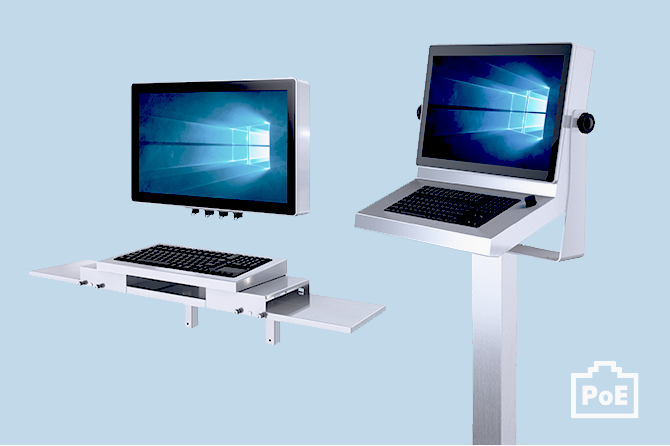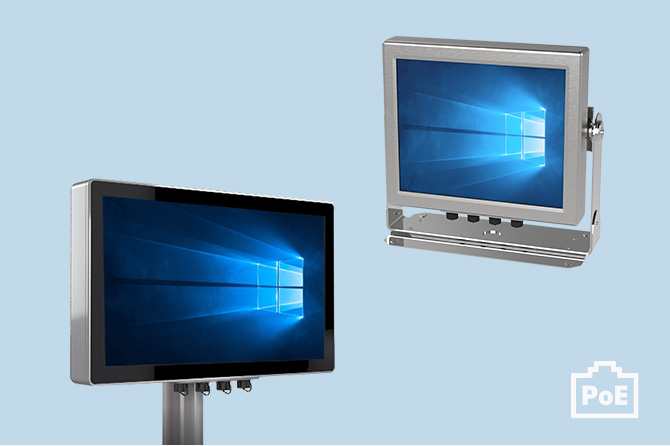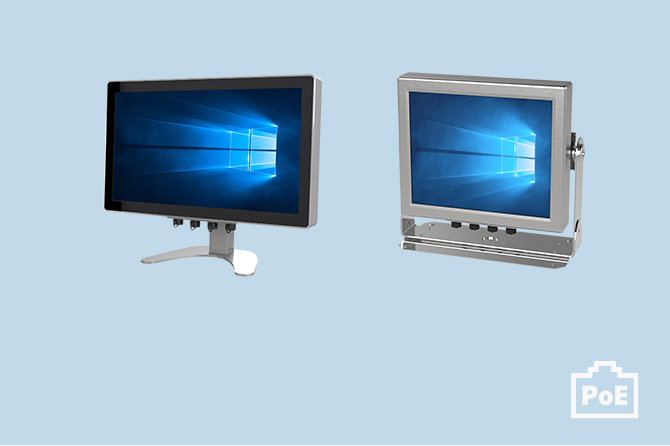ARISTA Workstations, Panel PCs, and Thin Clients with NEMA 4X / IP66 are Powered by 802.3bt Type 3/4 PoE

Powered By PoE Benefits
You can deploy easily a Powered by PoE device within 330 feet with a single Cat cable, one set of twisted-pair wires for both data and power supply, and save money by eliminating the need to run electrical wiring.
PoE Standards and Specifications
The original IEEE 802.3af-2003 PoE standard provides up to 15.4 W of DC power on each port. The updated IEEE 802.3at-2009 PoE standard, also known as PoE+ or PoE plus, allows for up to 30 W of power to Type 2 devices. That’s sufficient power for devices such as VoIP phones, wireless access points, and security cameras. But it’s not enough for technology like flat screen displays, LED lighting, or retail POS terminals.
Introducing the 802.3bt PoE Standard
To meet the demand for higher power, the IEEE released a new PoE standard at the end of 2018, to significantly increase capacity. IEEE 802.3bt allows for up to 60 W to 100 W of power at the source by providing power over four pairs of wires (compared to the previous technology’s ability to power over just two pairs). This increase in power allows you to use PoE for a greater range devices and applications. As an added benefit, the new standard will boost energy efficiency by minimizing power loss in the cable, potentially cutting power loss in half.
The new standard will include support for 2.5GBASE-T, 5GBASE-T and 10GBASE-T, while existing standards have a maximum speed of 1-Gbps. This new support will create intermediate data speeds between existing standards.
PoE Types and Power Levels
Previous PoE technology included PoE Type 1, also called IEEE 802.3af, and PoE Type 2, better known as 802.3at or PoE+. Both utilize 2-pair Power over Ethernet, Type 1 with a maximum of 15.4 W per port and Type 2 with a maximum of 30 W per port.
With the new 802.3bt standard come two new options: Type 3 and Type 4. Type 3 is also called 4-pair PoE, 4PPoE, PoE++, or UPoE. It provides 60 W of power per port and is ideal for video conferencing equipment, multi-radio wireless access points, PTZ cameras, and building management devices.
Type 4 (another designation is high-power PoE) offers the highest power capabilities, potentially up to 100 W of DC power (71.3 W to each device), and can support flat screens and laptops. For more detailed specifications on PoE Type 4 and other types, you can refer to the following table.
| PoE Standard | Voltage @ PD | Voltage @ PSE | Minimum power for PD* | Minimum output @ PSE | Supported Modes | Maximum cable length |
| IEEE 802.3af | 37-57 V | 44-57 V | 12.95 W | 15.40 W | Mode A + B | 100 m |
| IEEE 802.3at | 42.5-57 V | 50-57 V | 25.5 W | 30 W | Mode A + B | 100 m |
| IEEE 802.3bt Type 3 | 42.5-57 V | 50-57 V | 51 W | 60 W | Mode A + B, 4-pair mode | 100 m |
| IEEE 802.3bt Type 4 | 41.1-57 V | 52-57 V | 71 W | 100 W | Mode A + B, 4-pair mode | 100 m |
Cables Considerations
PoE switches and injectors are based on the rules defined by the IEEE 802.3 working group. As such, no special cabling is required. Keep in mind, though, that Ultra-PoE connections require 8-pin network cabling. Almost all networking cabling is 8-pin, but there is inexpensive cable out there that may only come with 4-pins. As those can only be used for Fast-Ethernet connections, they have become increasingly rare.
There’s a lot of (mis)information out there about the drawbacks of this cable type. Copper-Clad Aluminum (CCA) cable uses an aluminum (aluminum) core and is coated with copper. It contrasts with regular network cable that has a 100% copper core.
Simply put, aluminum isn't as good an electrical conductor. It has a higher DC-resistance value than copper, so more power is lost and dissipated as heat (and it only gets worse the longer the cable connection is). Higher heat and the larger power loss on the cable are both major concerns in PoE applications, so we do not recommend using them with PoE injectors or switches.
For standard networking applications, CCA cables usually get the job done just fine and cost less than 100% copper cable.
Conclusion: Demand 100% copper network cable from your supplier for PoE applications.
PoE Injector and Splitter
To be benefited by PoE technology, PoE Injector and PoE splitter can be used if PoE Switch is not available.
PoE Injectors
PoE injectors inject data and power simultaneously over a single Ethernet cable. Arista provides an injector that has a 48~57VDC input the and data input and PoE output. With a separate power supply, Arista’s PoE injector provides a better power loss compensation due to cable power loss.
PoE Splitters
PoE Splitter receives a PoE signal and converts it into data and power. PoE splitter separates data and power onto two different lines to support non-PoE devices. Arista provides a PoE splitter that can receive 802.3bt Type 3 PoE signal and converts a data line and a 24VDC@2.1A power line. The models listed below are compatible with this PoE injector:





